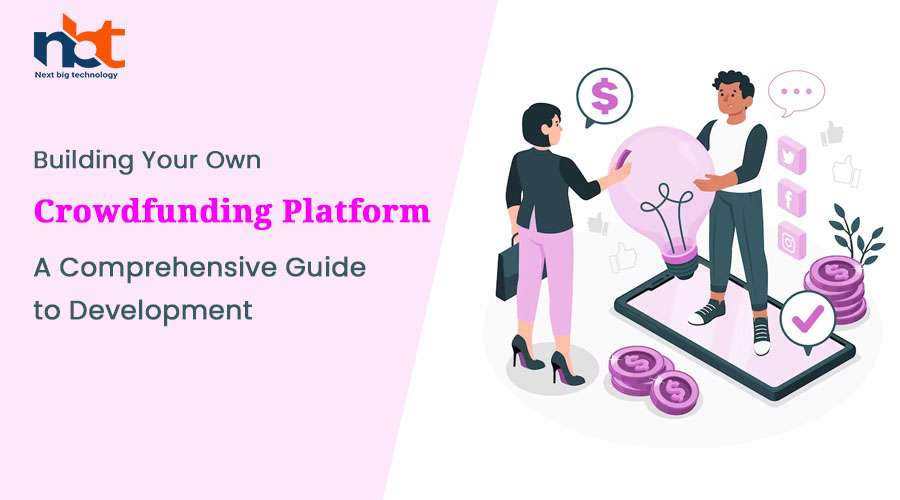Title: Building Your Own Crowdfunding Platform: A Comprehensive Guide to Development
Introduction: Crowdfunding has emerged as a popular method for entrepreneurs, artists, and social initiatives to raise funds from a large number of individuals. Inspired by the success of crowdfunding platforms like Kickstarter and Indiegogo, many entrepreneurs and businesses are interested in developing their own crowdfunding platform. In this blog, we will provide a comprehensive guide to developing a crowdfunding platform, covering key aspects from planning to implementation.
- Understanding Crowdfunding: Before diving into development, it is crucial to understand the concept and models of crowdfunding. Crowdfunding is a fundraising method that allows individuals or organizations to raise money for a specific project or venture through small contributions from a large number of people, typically via an online platform. There are different models of crowdfunding, including reward-based, donation-based, equity-based, and lending-based. Understanding the core principles and mechanics of crowdfunding will guide the development process of your platform.
- Market Research and Target Audience: Conducting market research is essential to identify your target audience and assess the potential demand for your crowdfunding platform. Analyze the existing crowdfunding market, identify specific niches or underserved segments, and understand the preferences and needs of both project creators and funders. This research will help you tailor your platform to meet specific requirements, differentiate from competitors, and provide a compelling value proposition to your target audience.
- Defining the Feature Set: Based on your market research, outline the features and functionalities you want to incorporate into your crowdfunding platform. These may include:
- User Registration and Profiles: Allow project creators and funders to create accounts, build profiles, and manage their information.
- Project Creation: Enable project creators to create and customize project pages, including project descriptions, funding goals, rewards, and multimedia content (images, videos, etc.).
- Payment Integration: Integrate secure payment gateways to facilitate fund transfers between funders and project creators.
- Reward Fulfillment: Provide tools for project creators to manage and fulfill rewards promised to funders upon successful project completion.
- Social Sharing: Implement social media integration and sharing features to allow users to promote projects within their networks.
- Project Discovery and Search: Develop a user-friendly interface for funders to discover and search for projects based on categories, popularity, funding status, and other relevant filters.
- Project Updates and Communication: Enable project creators to provide regular updates to funders, fostering transparency and engagement throughout the funding process.
- Backer Engagement: Facilitate interaction between project creators and funders, allowing them to communicate, ask questions, and provide feedback.
- Analytics and Reporting: Provide project creators with analytics and reporting tools to track their project’s performance, funding trends, and user engagement.
- Technology Stack Selection: Choosing the right technology stack is crucial for building a scalable and efficient crowdfunding platform. Consider using technologies such as:
- Backend Development: Node.js or Ruby on Rails for server-side development, handling user requests, data storage, and API integrations.
- Database: PostgreSQL or MongoDB for storing and retrieving user data, project information, funding transactions, and other relevant data.
- Frontend Development: React.js or Angular for building an intuitive and responsive user interface.
- Payment Integration: Integrate with popular payment gateways such as Stripe, PayPal, or Braintree to handle secure transactions.
- Cloud Infrastructure: Host your application on cloud platforms like AWS or Google Cloud for scalability, high availability, and performance optimization.
- UI/UX Design: Invest in a visually appealing and user-friendly interface for your crowdfunding platform. Focus on intuitive navigation, clear project presentation, easy-to-use search and discovery features, and a seamless funding experience. Prioritize responsive design to ensure a consistent experience across different devices. Collaborate with experienced UI/UX designers to create an engaging and user-centric platform.
- Development Process: Follow an agile development approach, breaking the project into manageable sprints and milestones. Divide the development tasks into frontend, backend, and database development, ensuring proper integration and testing at each stage. Regular testing and quality assurance processes are essential to identify and fix any bugs or issues early on.
- Security and Trust: Implement robust security measures to protect user data, ensure secure transactions, and build trust within your crowdfunding community. Employ secure user authentication mechanisms, utilize encryption for sensitive information, and implement fraud detection measures. Comply with relevant regulations and provide transparent terms of service and privacy policies.
- Launching and Deployment: Before launching your crowdfunding platform, conduct thorough testing to ensure a seamless user experience. Test functionality, performance, responsiveness, and security. Deploy your platform to a reliable hosting provider, ensuring scalability and high availability to handle increasing user traffic. Monitor user feedback and continuously iterate on your platform to improve and optimize its performance.
- Building a Community and Marketing: To stimulate the growth of your crowdfunding platform, focus on building an active and engaged community. Implement features that encourage user interaction, facilitate communication between project creators and funders, and foster a sense of community. Develop effective marketing strategies to attract project creators and funders to your platform. Utilize content marketing, social media marketing, influencer partnerships, and targeted advertising to raise awareness and drive user acquisition.
- Ongoing Support and Maintenance: Once your crowdfunding platform is launched, provide ongoing support and maintenance to ensure its smooth operation. Continuously monitor the platform for any issues, respond to user queries and feedback promptly, and release regular updates to improve functionality, address security vulnerabilities, and introduce new features. Offer excellent customer support and provide resources and guidance to help project creators and funders make the most of the platform.
Conclusion: Developing a crowdfunding platform requires careful planning, comprehensive development, and ongoing support. By conducting market research, defining the feature set, selecting the right technology stack, and prioritizing user experience, you can create a robust and user-friendly platform. Leveraging the expertise of experienced developers and designers, as well as implementing effective marketing strategies and fostering a supportive community, will help you establish a successful crowdfunding platform where project creators can bring their ideas to life and funders can contribute to meaningful projects.

















